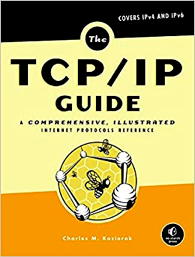TCP/IP Guide: A Comprehensive, Illustrated Internet Protocols Reference
reviewed by Jonathan Hoyle and Robert Pritchett
|
Author: Charles M. Kozierok No Starch Press Book Sites: https://www.nostarch.com/tcpip.htm Released: September 2005. Pages: 1,616 $80 USD, $108 CDN, £55 GBP, €72 Euro ISBN: 159327047X Audience: Software developers interested in programming to the TCP/IP specification. Strengths: Clearly written and well organized, breaking down many difficult concepts into manageable pieces. Weakness: It is not always obvious what portions of TCP were the important parts and which were minor. |
|
TCP/IP Guide: A Comprehensive, Illustrated Internet Protocols Reference by Charles M. Kozierok took a lot of research and time getting here, but it really is what the title say; comprehensive and illustrated. And with 1,616 pages, did you expect anything less? If my calculations are correct it took no less than 4 years for Charles Kozierok to put this intensive tome together.
(by Jonathan)
This is one of the most comprehensive references available on the subject of TCP/IP. At over 1,600 pages, author Charles Kozierok succeeds in organizing this involved subject into an introductory section, a general section for application developers, and one for low-level programmers who need detailed access to the protocol. Key concepts are sectioned off in bolded text on a gray background as a visual cue. The many diagrams and illustrations are welcome in helping to explain the most complicated concepts. Kozierok's writing style is engaging and informative, especially in the introductory chapters.
In Part I, Kozierok gives an overview of the TCP protocol and background information. In addition to giving an overview and history on the protocol itself, the author also takes the time to explain the rationale behind the various decisions made in the evolution of this standard. In this section, Chapter 2 is particularly interesting, covering general concepts and even performance issues associated with TCP/IP. Part II covers the Lower-Layer protocols, such as the IPV4 and IPV6 standards. Gateway protocols are the covered, and most especially Transport Layer protocols. A well-explained comparison between TCP and UDP is made, going into detail on the addressing of ports and sockets. Part III covers Application Layer protocols, useful for web programmers and developers for FTP, email and host configuration.
The book is not meant to be read sequentially (at least after Part I), as it is a reference source for all aspects of TCP/IP. Each chapter introduces the main concepts used within, and information is often displayed in tabular form for easy digesting. The author likes to explain the "why's" along with the "what's", making each of the chapters easy to read, unlike the many dry tomes currently available. As a supplement to the book, Kozierok has a web site at http://www.tcpipguide.com for continued learning of TCP/IP.
Overall, the TCP/IP Guide will be a must-have for any serious software developer interesting in writing to this protocol. Although the beginner might be a better served with a lighter volume, not weighed down with the details found herein, any moderate to advanced developer will want to keep a copy of this on his or her desk.
(by Robert)
Now I can retire all my other TCP/IP books I have gathering dust on my bookshelves. Oh, wait, I guess I can keep them as relics from times past and perhaps become collector’s items. No, I looked at Amazon.com and they hold little value today. This book however may become timeless, because it not only talks about, but shows “everything”.
Once, while I was in a telecommunications engineering group we had the opportunity to buy a bunch of plastic-coated strips that showed each protocol ad nauseum, and if memory serves me right, each one cost upwards of $30 USD. We picked and chose the ones we actually used or knew something about at the time. Here is a book that costs $80 that not only shows what those cheat sheets had, but much, much more.
The Table of Contents, List of Figures, List of Tables go on for nearly 70 pages. There are over 350+ illustrations, 500 tables and something about every single network protocol acronym known to man – including IPv6. And beyond the 40-page Index there is a 3-page list of the Requests For Comments (RFCs) by Number. And Charles Kozierok made the text readable. Maybe that is why the book took over 4 years to complete. No assumptions are made about what you may or may not already know about networking, but he is kind enough to point out that certain parts can be skipped if you “know something already”. The book could have been broken out into three sections, much like Douglas Comer and David Stevens did with their 3-volume set of “Internetworking with TCP/IP” that was published way back in the early 1990s. Instead, the three sections are all bound together so they don’t get lost or misplaced. And the hard-cover binding lays out the pages nicely so the spine can’t be broken. Section I covers an overview and background information in eight chapters. Part II handles the lower layer core protocols, including IPv6, and all the familiar (to IT network types) acronyms I’m not going to repeat here in no less than 40 chapters. Part III finishes up the book from chapters 50 to 88 on everything you ever wanted to know about Application Layer Protocols.
You know, I wished I’d had this book way back when I got certified as a LAN specialist. And I don’t think this book is going to collect dust on any network engineer’s desktop anytime soon. And as big and heavy as this book is, I don’t think it will take 4 years to get through it – unless you are a really slow reader.
Probably one of the best ideas that are in this book are the short Key Concept paragraphs interspersed liberally throughout the book. These obviously help with reading comprehension and aid in understanding.
And if the pages in the book become obsolete, there is always the TCPIPGuide website posted above to turn to.
Anybody responsible for network management are going to want to get this book, so they can gain a full understanding of just how far we have come over the last 40 or so years.
And I like the cover; bees going back and forth between interlinked honey hives instead of spiders spinning webs.
If you are into learning TCP/IP, get your knowledge here.














